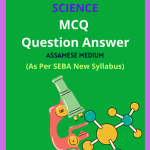Class 8 Science MCQ Chapter 1 Crop Production and Management Solutions in English Medium, Class 8 Science Multiple Choice Question Answer in English to each chapter is provided in the list so that you can easily browse throughout different chapters Class 8 Science MCQ Chapter 1 Crop Production and Management Notes and select need one.
Class 8 Science MCQ Chapter 1 Crop Production and Management
Also, you can read the SCERT book online in these sections Class 8 Science Objective Type Solutions by Expert Teachers as per SCERT (CBSE) Book guidelines. These solutions are part of SCERT All Subject Solutions. Here we have given Assam Class 8 Science MCQs Solutions in English for All Subject, You can practice these here.
Crop Production and Management
Chapter – 1
| MCQ |
1. The Crops which are grown in rainy season are called
(a) Rabi crop.
(b) Seasonal crop.
(c) Monsoon crop.
(d) Kharif crop.
Ans: (d) Kharif crop.
2. Which of the following description is true for describing ‘fertiliser’
(a) Used in large quantity.
(b) Organic in nature.
(c) Does not cause pollution.
(d) Produced in factories.
Ans: (d) Produced in factories.
3. The process of separating grains from chaff is known as:
(a) threshing.
(b) harvesting.
(c) winnowing.
(d) transplantation.
Ans: (a) threshing.
4. Which of the following can make their own food:
(a) humans.
(b) animals.
(c) plants.
(d) all of these.
Ans: (c) plants.
5. Which of the following nutrients replenishes the soil after growing leguminous plants?
(a) Nitrogen.
(b) Oxygen.
(c) Phosphorus.
(d) Potassium.
Ans: (a) Nitrogen.
6. The tool used for removing weeds is:
(a) plough.
(c) hoe.
(b) leveller.
(d) none of these.
Ans: (d) none of these.
7. Watering the crops is called:
(a) sowing.
(b) manuring.
(c) tilling.
(d) irrigation.
Ans: (d) irrigation.
8. Pesticides are used to destroy:
(a) pests.
(b) weeds.
(c) crops.
(d) none of these.
Ans: (a) pests.
9. Which of the following is not a fertiliser:
(a) urea.
(b) cow-dung.
(c) potash.
(d) super phosphate.
Ans: (c) potash.
10. The farm appliance ‘Combine’ is a combined:
(a) Plough and Harvester.
(b) Seed drill cum Thresher.
(c) Harvester and Thresher.
(d) Harvester cum Sprayer.
Ans: (c) Harvester and Thresher.
11. Animals like horse, donkey that carries load are called:
(a) Drought species.
(b) Load carrying Animals.
(c) Dairy Animals.
(d) Draught Animal.
Ans: (c) Dairy Animals.
12. At home to store grains we use:
(a) wet neem leaves.
(b) dried neem leaves.
(c) dried mango leaves.
(d) dried peepal leaves.
Ans: (b) dried neem leaves
13. What is NPK?
(a) Fertiliser.
(b) Manure.
(c) Weedicide.
(d) Weed.
Ans: (c) Weedicide.
14. Rhizobium bacteria is present in the nodules of the roots:
(a) wheat.
(b) leguminous plants.
(c) maize.
(d) onion.
Ans: (d) onion.

Hi! my Name is Parimal Roy. I have completed my Bachelor’s degree in Philosophy (B.A.) from Silapathar General College. Currently, I am working as an HR Manager at Dev Library. It is a website that provides study materials for students from Class 3 to 12, including SCERT and NCERT notes. It also offers resources for BA, B.Com, B.Sc, and Computer Science, along with postgraduate notes. Besides study materials, the website has novels, eBooks, health and finance articles, biographies, quotes, and more.




